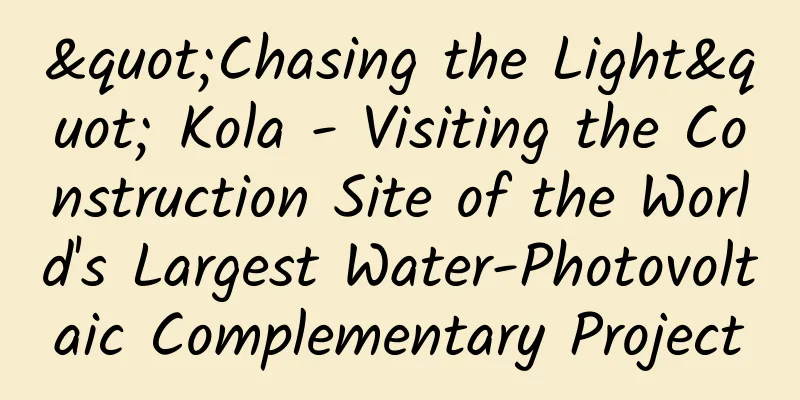"Chasing the Light" Kola - Visiting the Construction Site of the World's Largest Water-Photovoltaic Complementary Project

|
——Visiting the construction site of the world's largest water-solar complementary project "Kola" is Tibetan, meaning "three large grasslands". Looking at the map, the rolling mountains are like capillaries. The natural geographical location and the high altitude of 4,600 meters create rich solar energy resources. In this ancient and peaceful land, people live and multiply, working from sunrise to sunset. In September 2022, an explosion broke the silence, and the Zhalatosang Mountain, which had been dormant for a thousand years, regained its vitality due to the start of construction of the first phase of the Kola Photovoltaic Project, the world's largest hydro-photovoltaic complementary power station. How to change thinking? Finding a balance between active and passive With the in-depth advancement of major strategies such as the country's green and low-carbon transformation, the 14th Five-Year Plan, regional economic layout, new energy system planning, and digital economic development, the Seventh Hydropower Bureau has ushered in major development opportunities. How to get a share of the pie in the fierce competition in the new energy market? The only way is to take the initiative. They opened up a new situation in the changing situation, took the initiative, and jointly with the East China Institute, successfully won the bid for Section II of the Phase I Project of the Kola Photovoltaic Power Station, responsible for the photovoltaic array area, booster station, roads, and rural revitalization projects. The Kola Photovoltaic Power Station is the world's largest hydro-photovoltaic complementary project, and it is also the first time that the scale of the global hydro-photovoltaic complementary project has been raised to the million-kilowatt level. After its completion, it will be connected to the Lianghekou Hydropower Station, and the hydro-photovoltaic complementary and "bundled" output of stable electricity will become a new model for the large-scale centralized development of clean renewable energy in the world. Participating in the construction of a "heavyweight" project is undoubtedly a self-transcendence for the builders. They started late, had no construction experience, and no high-quality cooperation team. How could they compete with others? The construction of photovoltaic power stations is a labor-intensive industry with a short construction period and a large amount of work. During the peak construction period of Section II alone, more than a thousand people may be involved, which places higher demands on management. "The winter temperature in Kola is around minus 25 degrees Celsius at night. The temperature difference between day and night in the construction area reaches 30 degrees. The permafrost is covered with hidden ice, and the efficiency of personnel and machinery is aggravated. After the concrete is poured, it is necessary to use five layers of insulation, including film, quilt, dust-proof cloth, and electric heater. In the face of serious machine efficiency reduction, it is pressurized and oxygenated. Workers work one-third slower here than on the plains, and we must increase the number of staff..." Project leader Li Jian recounted how to lead the team to tackle difficult problems. In this new golden track, there are five brother units within the group alone, and everyone is competing secretly. This is not only a test paper, but also a battle to defend our honor. Compared with the mature management model and market reputation of other brother units, in the final stage of the battle, we can only be extremely alert and cross the river by feeling the stones, and we must "cross the river" safely. How to break through the bottleneck? Break down barriers through exploration and hard work What can you do in 3 minutes? In the Kola photovoltaic power plant, ideally, one worker can install one photovoltaic panel. Here, the construction progress is measured in minutes. People who don't know the situation think that photovoltaic power plants are just about installing photovoltaic panels, and there is no challenge. Speaking of this, Li Jian is a little helpless. Li Ning, the project chief engineer, did some calculations. Excluding the winter break and environmental impact, the golden time for construction is no exaggeration to say that it is directly halved compared to the contract period. There are 78 arrays with about 19,450 strings and more than 500,000 photovoltaic panels. The goal of grid-connected power generation is imminent. How to race against time? The peak was right at the entrance, but the sleep disturbance caused by altitude sickness meant that everyone could only rest for 4 hours at most. Everyone's eyes were bloodshot due to long-term lack of sleep, and they were also forced to "lose weight", but they didn't complain at all, saying that they could overcome it, which made people feel distressed. The pile foundation uses H-shaped steel piles which are rare in China. The total number of piles to be constructed in Section II is more than 90,000. The original design ratio of the number of holes to the static pressure was 3:7, and there was no relevant experience to draw on. After a later geological survey on site, Li Ning and his team found that the amount of drilling holes must be increased to at least 95% to ensure the safety and stability of the upper photovoltaic panel brackets and components. Increasing the amount of drilling holes means that the construction difficulty coefficient will rise sharply, and the maximum slope of drilling hole construction is 15 degrees, while the maximum slope within the construction scope undertaken by the project department is 28 degrees. "To do it or not?" Only by risking everything can you survive. The project department immediately took the initiative to start pile foundation construction by drilling holes. They developed a method of "drilling holes first, then static pressure, and then backfilling" according to local conditions. Sometimes they added a "static pressure" after "backfilling" to compact and stabilize the loose "frozen tofu" foundation. There is another trick to improve efficiency: install a funnel-shaped stabilizer between the pile body and the ground, which can increase construction efficiency by 40% and the hole quality qualification rate to more than 70%. The booster station is the "heart" of the photovoltaic power station. After the light energy is converted into electrical energy, the current is transmitted through the booster station for grid-connected power generation. Facing the challenge of high cold in winter, the project department has developed a method of "adding clothes and covering quilts" to keep the poured concrete warm, so as to avoid problems such as loose structure and insufficient strength caused by huge temperature differences. In addition, hot water mixing, accelerated coagulants, and antifreeze agents are used to increase the temperature of concrete entering the warehouse, the setting time, and the antifreeze property to ensure the quality of concrete construction. As a key project, the equipment installation requirements of the booster station are also unusual: the main transformer and GIS installation environment must be "dust-free". Once dust enters the mother pipe, it will be directly scrapped under the high pressure during the pressure test, and all efforts will be reset to zero. This is like asking a doctor to perform a "dust-free" operation in the desert, and sandstorms can occur at any time. What to do? Create a dust-free environment. They put on a "protective cover" for the booster station and set up two protective doors. Workers must wear protective clothing before entering. They also kept an eye on weather changes and seized the daily construction window. Finally, they successfully completed the booster station equipment installation task and passed the acceptance, taking a big step towards grid connection. How to integrate into the local community? Seeking opportunities in responsibility and protection Suolang Qupo is a villager from Yinyin Village, Kela Township, and has lived here for generations. He never thought that his life would undergo earth-shaking changes due to the construction of the Kela photovoltaic power station. "I used to only be able to herd sheep, but now that you're here, I can work on a construction site and earn a salary, Tashi Delek." He kept saying "thank you" in not very standard Mandarin. "We have jobs ready for them at any time," said Wang Yuanxun, deputy secretary of the project party branch. The project department recruited workers from several neighboring villages such as Yiyin Village and Jiefang Village through the township government, providing more than 100 jobs for local villagers, driving local villagers to find jobs near their homes. "Through hands-on teaching, we imparted knowledge, and the villagers learned a skill. When they go out in the future, they can also support themselves with their skills." The project department has always insisted on treating "photovoltaic + infrastructure improvement" and "photovoltaic + employment" as major and important matters, actively fulfilling its social responsibilities, driving the development of agriculture, animal husbandry, tourism, transportation and other industries in ethnic areas, and generating "photovoltaic + N" benefits. When the project team first entered the site, they planned to renovate and expand the roads in the village, including the mechanized farming roads of the nine households on the mountain, which completely solved their travel problems. Local villagers suddenly fell ill and needed medical treatment. The only bridge leading to the outside world was damaged by heavy rain. When they saw the red flag flying high in the project department, they took the initiative to come over for help. The project department immediately set up a party member assault team, organized emergency repairs of machinery and equipment, and solved the villagers' urgent needs. At the beginning of the construction of the water supply project, the project department took the villagers' drinking water safety into consideration, laid pipes for the villagers, and brought water into their homes so that they could drink clean and safe tap water... Each and every one of these is a true reflection of the responsibility of the Kola project party branch and its deep bond with the local people. Walking in Kola, you will encounter many simple smiling faces that are blooming because of the construction of photovoltaic power stations and the beauty of their hometown. On-site aerial photography Pile foundation construction Construction Site |
<<: "Shenzhou 16" is in place! Come and feel the magnificent momentum of the "Shenjian"
Recommend
Excellent case study sharing: How was the cost of information flow advertising reduced by 75%?
With the implementation of the housing purchase r...
How to create a landing page with high conversion rate? Share 2 pictures!
Unlike traditional industries that can bring prod...
In the next three to five years, China's home appliances industry will have two major opportunities.
In the next 3-5 years, China's home appliance...
A work checklist for self-media people!
It seems easy to create your own media , but it i...
Put down the remote control and go to the cinema. This is the truth behind the rise of cinema chains.
When the Internet connects living rooms, every fa...
How much does it cost to be an agent of a pet mini program in Huludao?
For entrepreneurs, although mini program developm...
Eating this way really slows down aging! 8 antioxidant foods are not only anti-aging, but also...
From ancient times to the present, people have be...
Offline marketing activities process and techniques!
A little background information – a large-scale e...
Android Wear is also about to be upgraded to 5.0, and the watch face display mode is turned on
In this era of personalization, you may also thin...
How much does it cost to join the Zhangbei children's clothing mini program?
How much does it cost to join the Zhangbei childr...
Millions of dollars were stolen from Pinduoduo. What is the trick behind the coupons?
The e-commerce "Internet celebrity" Pin...
Data | Online advertising revenue exceeded 67 billion in Q2 2016, data drives advertising value increase!
Overview of Internet Advertising Development in Q2...
What are the advantages of mobile high-bandwidth servers?
What are the advantages of mobile high bandwidth ...
5 user growth strategies from attracting new users to awakening them!
I will share my data operation experience in the ...
Mobile phone trivia: Why do most people only choose 8GB memory phones? There are two main reasons
First of all, it’s time for science. The 6G or 8G...




![Ningxia College Entrance Examination Score Line 2020 [First and Second Score Line Released] 2020 Ningxia College Entrance Examination Score Line List](/upload/images/67cc3b9cd447d.webp)




